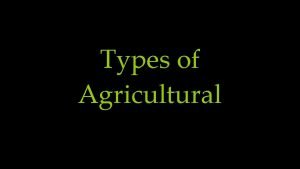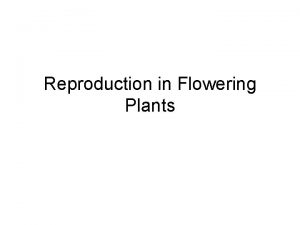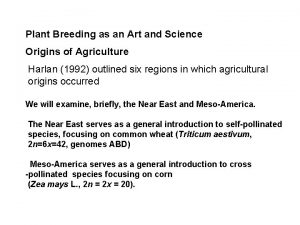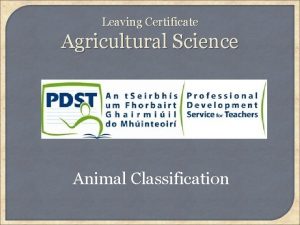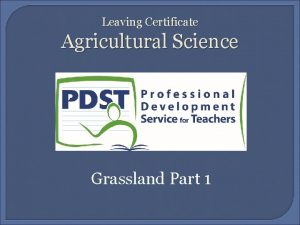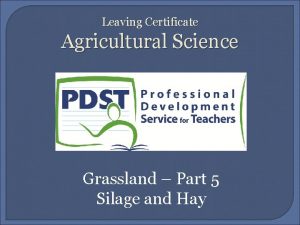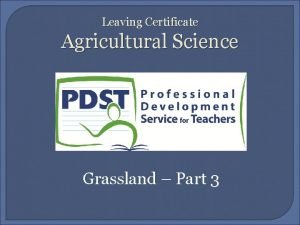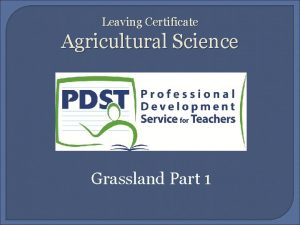Leaving Certificate Agricultural Science Plant Classification Part 2

















- Slides: 17

Leaving Certificate Agricultural Science Plant Classification – Part 2

Rosacae � Also � It known as the Rose Family. includes apple, pear, peach, plum, cherry, apricot, almond, nectarine, prune, raspberry, blackberry, dewberry and the strawberry. � They are characterised by five sepals and petals and numerous carpels and stamen.


Leguminosae � Also called the pea family, they are characterised by five petals (One large, two small and two even smaller “wings”). � A common feature in the family is the presence of root nodules containing bacteria of the genus Rhizobium. � These bacteria convert atmospheric N, which cannot be used by the plants, into nitrate (NO 3 -), a form that can be used. � This family is the second most economically important family after grasses and has over 18, 000 species. � Important species include peas, clover, vetch as well as gorse, a pest in some farms


Liliaceae � This is a monocot family, whose members include onions, garlic, lilies, tulips, bluebells and hyacinths. � This family is characterised be fused petals and sepals. � Their floral parts are in multiples of three – six sepals, six petals, six stamen and three carpels.


Gramineae � This is the grass family, and includes all grass species as well as cereals such as wheat, oats, barley maize and rice (and bamboo). � Grass species have flower structures based on the use of wind pollination. � Therefore they do not contain bright, colourful petals to attract insects, as this is not required. � Grass plants produce high levels of pollen to increase its chances of reproduction – this high level of pollen cause hay fever. � Grass flowers are said to be hermaphrodite – they contain both male and female parts. � These are formed on an inflorescence.


Compositae � This is the largest family of plants (NB) and includes daisies, dandelions, thistles, lettuce and sunflowers. � The family is called Compositae because each flower is actually a composite of many “florets”. � If you look at a daisy, you will find to different types of floret (the white “ray” floret and the yellow “disc” floret.


Umbelliferae � Members of this family have a distinctive florescence (collection of flowers) shaped like an umbrella. � Each of the flowers are small but contain five sepals, stamen and petals and two carpels. � Members of this family include parsley, dill, celery, carrots and parsnips. � Giant hogweeds and cow parsnip (parsley) are also weeds belonging to this family.


Other Families Raunculaceae � The buttercup family. Solanaceae � This family contains potatoes, tomatoes, tobacco and the “deadly nightshade”. Polygonaceae � Rhubarb family – rhubarb, dock and buckwheat.



 Leaving certificate history syllabus
Leaving certificate history syllabus Primary school leaving examination in chinese
Primary school leaving examination in chinese Leaving certificate
Leaving certificate Whittlesey classification
Whittlesey classification Whittlesey agricultural regions
Whittlesey agricultural regions What are your favorite subjects
What are your favorite subjects Computer science certificate princeton
Computer science certificate princeton Oten clinical coding
Oten clinical coding Plant introduction
Plant introduction Plant introduction in plant breeding
Plant introduction in plant breeding Plant introduction in plant breeding
Plant introduction in plant breeding Tronsmo plant pathology and plant diseases download
Tronsmo plant pathology and plant diseases download Tronsmo plant pathology and plant diseases download
Tronsmo plant pathology and plant diseases download Albugo eye
Albugo eye Selective breeding
Selective breeding Why plant breeding is an art
Why plant breeding is an art Part of the flower that produces pollen
Part of the flower that produces pollen Main parts of plant
Main parts of plant



